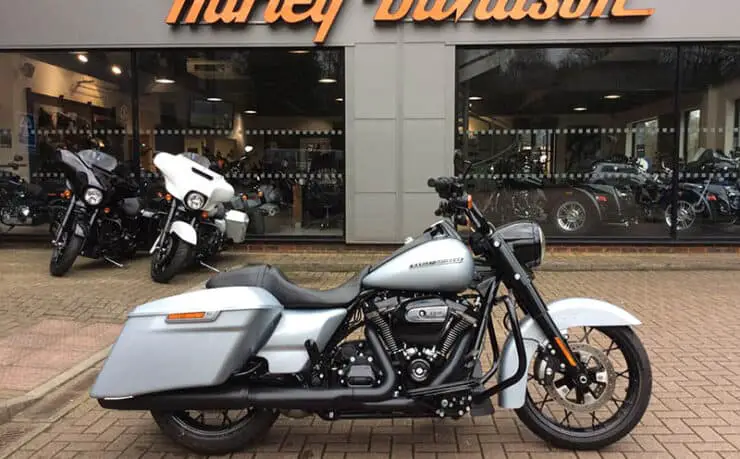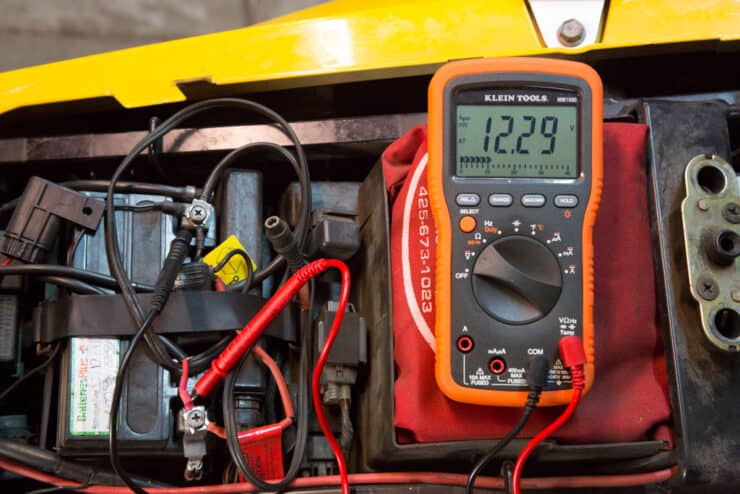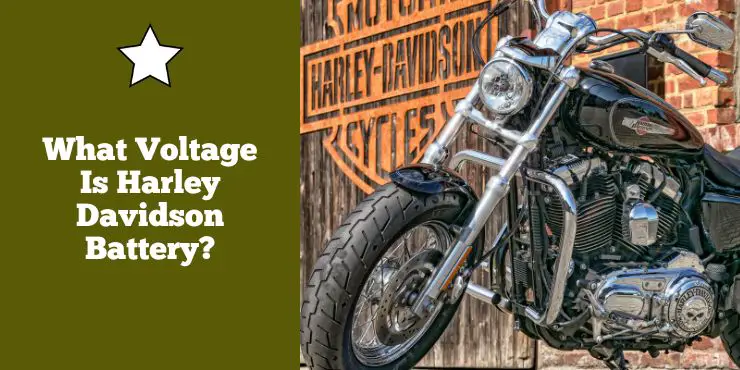Are you a Harley Davidson enthusiast? Do you want to know the ins and outs of your bike? If so, then this article is for you! Learn all about Harley Davidson motorcycle batteries and their voltage levels, so you can get to know the power of your ride! Having this knowledge will help you take better care of your bike.
A Harley-Davidson battery is typically 12 volts.
So, let’s get started!
What does a Harley-Davidson motorcycle battery do?
The motorcycle battery is an important component of any motorcycle, including Harley-Davidson motorcycles. This component serves as the power source for starting the engine and providing electrical energy for different systems and accessories.
A motorcycle battery is a rechargeable battery that stores electrical energy in chemical form and converts it into electrical power when required. It typically consists of a plastic housing containing lead plates, an electrolyte solution, and a series of cells. The cells are connected in a series and they produce a series of direct current (DC) electrical output.
A Harley-Davidson motorcycle battery is important for a wide variety of reasons, such as starting the engine, electrical system power, backup power, and more. The primary function of a motorcycle battery is to provide the initial electrical energy needed for starting the engine. Once you press the starter button, the battery will supply power to the starter motor, enabling it to turn the engine over and initiate the combustion process.
Once the engine is running, the battery will continue to provide electrical energy to power various electrical components and systems. These include the ignition system, indicators, lights, audio systems, horn, and other accessories. In case of alternator or charging system failure, the battery will act as a backup power source, ensuring that the bike remains operational for a limited period. It’ll allow you to ride to a safe location or seek help without losing the electrical functionality.
Motorcycle batteries are typically lead-acid batteries, comprising led plates immersed in an electrolyte solution. During the discharge process, a chemical reaction will occur between the lead plates and the electrolyte, producing electrical energy. When the engine is running, the alternator will generate electrical energy that gets converted into DC by the regulator/rectifier. This current will then be used for charging the battery and powering the electrical systems simultaneously. The charging process will reverse the chemical reaction, converting the electrical energy back into chemical energy stored within the battery.
Harley-Davidson motorcycle batteries require regular maintenance for ensuring optimal performance and longevity. This includes cleaning the terminals, checking the electrolyte levels, monitoring the battery’s charge with a voltmeter, and more. Moreover, it is important that you follow the manufacturer’s guidelines for help with maintenance.

Different types of motorcycle batteries in Harley-Davidson bikes
When it comes to choosing a battery for your Harley-Davidson bike, understanding the different types of batteries available will help you make a better decision. Harley-Davidson batteries come in different types, each offering unique characteristics in terms of performance, longevity, and maintenance. Here are the different types of motorcycle batteries available for Harley-Davidson bikes –
#1. Conventional lead-acid batteries
Conventional lead-acid batteries have been a popular option for Harley-Davidson bikes for many years. These batteries consist of lead plates immersed in an electrolyte solution of sulphuric acid and water. Such batteries offer reliable starting power and they’re also relatively inexpensive. However, they do require regular maintenance including checking and refilling electrolyte levels. Further, they might also have a shorter lifespan in comparison to other battery types.
#2. AGM batteries
Absorbed Glass Mat batteries or maintenance-free batteries or Sealed Lead Acid (SLA) batteries are designed to be maintenance-free and require no electrolyte checking or refilling. These batteries make use of a specialized glass mate separator that absorbs and suspends the electrolyte, reducing the risk of acid leaks or spills. They offer excellent starting power, have a longer lifespan in comparison to conventional batteries, and are much more resistant to vibration and shock. They’re a popular option among Harley-Davidson bikers thanks to their convenience and reliability.
#3. Lithium-ion batteries
Lithium-ion (Li-ion) batteries have gained a lot of popularity in recent years thanks to their high energy density, lightweight construction, and longer lifespan. These batteries make use of lithium-ion technology, which provides more power in a smaller and lighter package compared to conventional lead-acid batteries. These batteries offer quick and consistent starting power, perform great in extreme temperatures, and have a longer shelf life.
Further, they also have a lower self-discharge rate, which means they can retain their charge for longer periods when not in use. However, Li-ion batteries tend to be more expensive than other types and need specific chargers to prevent damage or overcharging.
#4. Gel cell batteries
Gel cell batteries are also a popular type of sealed lead-acid battery used in Harley-Davidson bikes. These batteries make use of a gel-like electrolyte instead of a liquid solution. The gel electrolyte is immobilized, which makes the battery spill-proof and resistant to vibration. Gel cell batteries offer impressive starting power, a longer lifespan, and can be mounted in various positions.
They’re often used in Harley-Davidson motorcycles that experience high vibrations, such as custom models and off-road bikes. However, gel cell batteries are typically more expensive than conventional lead-acid batteries and might require a special charger for optimal performance.
What voltage is Harley-Davidson battery?
Harley-Davidson motorcycles use either 6V or 12V batteries. If the batteries are in good condition, their voltage might be a bit higher than that because the peak voltage of the battery cells is around 2.1V. The majority of Harley-Davidson bikes released in the last 60 years or so make use of 12V batteries. However, older Harley-Davidson models do use 6V batteries. Typically, Harley-Davidson bikes manufactured up to until 1964 made use of 6V batteries.
The right voltage for your Harley-Davidson bike will depend on the type of motorcycle battery it uses. For instance, if your bike uses a 12V battery, it’ll be considered fully charged when it reads 12.6 to 13.2V. Meanwhile, if it uses a 6V battery, it’ll be considered fully charged if it reads 6.3 to 6.6V. A 6V battery might be considered flat or dead at 5.25V whereas a 12V battery will be considered dead at 10.5V.

Does it matter if you use a 6V or 12V Harley-Davidson battery?
Knowing the ideal voltage for your Harley will be important as mismatching the battery’s voltage with the charging system and motor could result in issues. A Harley-Davidson bike that has been designed to run on 12V should use a 12V battery and be charged with a 12V battery charger. A 6V Harley-Davidson bike should use a 6V battery and be charged exclusively with a 6V battery charger.
Inserting a 12V battery on a bike designed to run on 6V could damage or even fry the motor and the electrical system. Meanwhile, a 6V battery won’t have the potential to power or even start a motorcycle designed for running on a 12V battery. If you try charging a 12V battery using a 6V charger, it won’t be possible to charge the battery at all since the charger will not be able to provide enough charge.
Jump-starting a 6V battery with a 12V charger can be quite dangerous as it can quickly damage or completely kill the battery. Even though it isn’t recommended but a 6V battery can be jump-started using a 12V battery. However, this should only be done when exercising extra caution while the other vehicle is turned off.
Moreover, there are also 24V batteries and battery chargers available in the market. They’re typically used on heavy trucks. However, if you’re looking to charge or jump-start your Harley-Davidson bike using a 24V battery or battery charger, it can quickly damage and destroy the original battery.
Meanwhile, 6V batteries are smaller and consist of three cells compared to 12V batteries, which consist of six cells. If you’ve purchased a 12V battery for your bike (which uses a 6V battery), you might find that you don’t have ample space to fit the battery.
Knowing what battery your Harley-Davidson bike uses is important as it’ll help you avoid doing any unintentional damage to your bike. You’ll be able to find out what replacement battery to purchase, how to jump-start your bike, and how to recharge your battery the right way. However, you must remember that the voltage isn’t the only aspect of the motorcycle battery you need to consider. The battery should also get the right levels of ampere-hours (Ah) and cold cranking amps (CCA).
How to find out if your Harley’s battery is 6V or 12V?
Even though the info mentioned above will help you identify your Harley-Davidson battery’s voltage without looking at the battery, it’ll still be a smart idea to have a visual inspection of the battery. This will allow you to confirm what type of battery you are dealing with. It would make sense as you will not be relying on the guessing game. Many people might think that a 12V battery is always larger than a 6V battery. However, this isn’t always the case, which means this rule will not help all the time. There are multiple ways you can tell exactly how many volts is your bike’s battery.
#1. Check your Harley’s owner’s manual
The type of battery your Harley-Davidson bike uses will be mentioned in the owner’s manual. This is definitely the easiest and most reliable way to tell what the voltage of your Harley-Davidson bike’s battery should be.
#2. Check the label on the battery
The next best thing you can do if you aren’t sure what year the bike was manufactured and you haven’t got the owner’s manual will be to check the motorcycle battery’s label. Often, motorcycle manufacturers mention various specifications, like the voltage (V), ampere-hours (Ah), and cold cranking amps (CCA). Moreover, there are also other details mentioned like the type of battery, the best charging methods, and time.
#3. Check the number of vent caps
Generally, motorcycle batteries are made up of several cells, each of which has around 2.1V, which means the 12V batteries have six cells while 6V batteries have three cells.
A quick visual inspection of the number of your Harley-Davidson battery’s vent caps will help you know if your bike uses a 6V or a 12V battery. Motorcycle batteries that are 12V will come with six vent caps on top for the 6 cells the battery has. Meanwhile, 6V batteries will come with three vent caps. Interestingly, even AGM (maintenance-free) batteries may have these caps, although they might be flush and not have any cell openings.
#4. Check the body of the battery
If you aren’t able to understand the methods so far, there is another way you can tell exactly how many volts the battery is.
You need to inspect the body of the battery. Typically, there will be slight dips or discolorations on the outside molding where the cell walls are present. Making use of these slight dips in the battery’s wall, you will be able to tell the number of cell compartments here.
#5. Measure the electrical system
If you still aren’t able to tell the battery’s voltage with the help of these methods, you can also measure the electrical system using a voltmeter or multimeter.
Key factors to consider when choosing the battery
Choosing the right battery for your Harley-Davidson bike will be key important for reliable starting power and optimal electrical system performance. With various battery options available, it’ll be important that you consider certain factors to ensure compatibility and longevity. Here are the key factors that you should consider when choosing a battery for your Harley-Davidson bike.
#1. Battery type
Harley-Davidson bikes typically use lead-acid, lithium-ion, and absorbed glass mat (AGM) batteries. Each type of battery has its advantages and considerations. Lead-acid batteries are quite cost-effective but need regular maintenance whereas AGM batteries are maintenance-free but more resistant to vibrations. Meanwhile, Lithium-ion batteries offer high energy density, lightweight construction, and a longer lifespan but they’re also more expensive.
#2. Battery size and fitment
You should make sure that the battery you have chosen fits your bike’s battery compartment and has all the correct dimensions to avoid any fitment issues. You must check the battery specifications and compare them with the manufacturer’s recommendations and your bike’s owner’s manual.
#3. Cold cranking amps (CAA)
Cold cranking amps (CCA) refer to the bike’s ability to deliver starting power in cold temperatures. It represents the amount of current the battery can supply at 0° Fahrenheit (-17° C) for 30 seconds while maintaining a voltage-specified threshold. You need to consider the climate in your area and look for a battery with an appropriate CCA rating to ensure reliable starting, especially in colder conditions.
#4. Reserve capacity (RC)
Reserve capacity indicates the motorcycle battery’s capacity to provide power to the electrical systems when the charging system fails. It’ll represent the time (in minutes) the battery is able to sustain a 25-amp load while maintaining a voltage above a specified threshold. A higher RC rating will ensure longer backup power, which will give you ample time to seek assistance or reach a safe location in case of a charging system failure.
#5. Brand and quality
You should go for a reputable brand known for its quality, reliability, and customer support. Look for batteries that meet industry standards and have a good reputation for durability and longevity. High-quality batteries typically come with longer warranties, indicating the manufacturer’s confidence in their product.

#6. Charging system compatibility
You should make sure that you’re choosing a battery that is compatible with your Harley-Davidson bike’s charging system. The charging system will provide the correct voltage and charging characteristics to match the battery’s requirements. You should consult your bike’s owner’s manual or seek guidance from a trusted mechanic to ensure compatibility.
#7. Maintenance requirements
Consider the preference for battery maintenance. Conventional lead-acid batteries typically require periodic checks of electrolyte levels and might also need refilling. In comparison, AGM and lithium-ion batteries are maintenance-free. This is why you should evaluate the level of maintenance you can undertake and choose the battery accordingly.
Maintenance requirements for Harley-Davidson motorcycle batteries
As mentioned above, proper maintenance of your Harley-Davidson battery will be significant for its longevity, optimal performance, and reliability. Regular upkeep will ensure that your bike’s battery stays in great condition and delivers the needed electrical power for your Harley. Here are the maintenance requirements you’ll need to carry out to take care of your Harley-Davidson battery.
Cleaning the battery
Regularly cleaning the battery will help prevent the build-up of dirt, debris, and corrosion. This can hinder its performance. To clean the motorcycle battery, you will need to carry out a series of steps.
Begin by disconnecting the battery cables, starting with the negative (-) cable, followed by the positive (+) cable. Use a mixture of baking soda and water or a battery cleaner specifically designed for battery maintenance. Apply the solution to a clean cloth or brush and scrub the battery terminals and connections for removing any dirt or corrosion.
Then, you should rinse the battery with clean water and ensure that all cleaning solutions are thoroughly washed away. Dry the battery terminals and connections using a clean cloth. Lastly, reconnect the battery cables, starting with the positive (+) one followed by the negative (-) cable. Make sure that the connections are securely tightened.
Charging the battery
Regularly charging the battery will help maintain its charge and prolong its lifespan. You should follow a series of steps to charge your Harley-Davidson bike’s battery. First, you should disconnect the battery cables, starting with the negative (-) cable and then the positive (+) cable. Make use of a compatible battery charger or a smart charger designed specifically for motorcycle batteries. Make sure that it has the appropriate voltage and charging capabilities.
Connect the charger to the battery terminals while making sure of the correct polarity. Follow the charger manufacturer’s instructions for charging. It’ll be important to choose the correct charging mode and set the appropriate charging parameters. Allow the battery to charge completely. Avoid overcharging by monitoring the charging process and disconnecting the charger once the battery is fully charged. Lastly, you should reconnect the battery cables, beginning with the positive (+) cable and then the negative (-) cable. Make sure that they are securely fastened.
Checking voltage and terminal connections
Regularly checking the voltage and terminal connections of your Harley-Davidson battery will be essential for the early detection of potential issues. It is important that you should follow certain steps to check the voltage and terminal connections.
Make use of a voltmeter or a multimeter for measuring the battery’s voltage. Further, ensure that the bike is turned off, and there will be no load on the battery. Connect the voltmeter or multimeter to the battery terminals. The voltage reading needs to be within the manufacturer’s recommended range. If the voltage is significantly lower than expected, the battery might require charging or replacement.
You should inspect the battery terminals and connections for signs of corrosion, loose connections, or damage. Make sure that the terminals are clean, tight, and free from any debris. If corrosion is present, you must follow the cleaning steps mentioned above to remove it. If any terminal connections are loose, you should tighten them appropriately to ensure a secure connection.
Also read: The Benefits of Installing Ape Hangers on your Motorcycle
FAQs
What voltage is a Harley Davidson battery?
Harley Davidson motorcycles use 12-volt batteries, with a total capacity of 12-14 amps. The battery is a sealed, maintenance-free type, and should typically be replaced every three to five years.
What is the best type of battery for a Harley Davidson?
The best type of battery for a Harley Davidson is a sealed, maintenance-free battery. This type of battery is designed to provide more reliable performance and longer life than conventional lead-acid batteries.
How can I tell if my Harley Davidson battery is going bad?
If your Harley Davidson battery is going bad, you may notice signs such as difficulty starting the motorcycle, dim or flickering lights, or a decrease in power output. You may also notice corrosion or bulging on the battery’s case. If you notice any of these signs, it’s important to have the battery checked and replaced if necessary.

